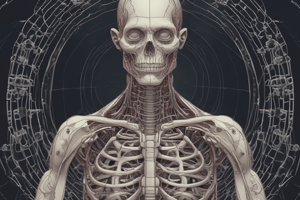Podcast
Questions and Answers
Which of the following is NOT a type of passive membrane transport?
Which of the following is NOT a type of passive membrane transport?
- Osmosis
- Simple diffusion
- Facilitated diffusion
- Active transport (correct)
What is the primary function of microvilli?
What is the primary function of microvilli?
- Increased surface area for absorption (correct)
- Production of proteins
- Movement of fluids
- Cellular communication
What type of feedback mechanism is involved in regulating blood glucose levels?
What type of feedback mechanism is involved in regulating blood glucose levels?
- Negative feedback (correct)
- Paracrine feedback
- Autocrine feedback
- Positive feedback
Which of the following best describes the difference between a sign and a symptom?
Which of the following best describes the difference between a sign and a symptom?
What is the function of the cell membrane's phospholipid bilayer?
What is the function of the cell membrane's phospholipid bilayer?
Flashcards
Anatomy vs. Physiology
Anatomy vs. Physiology
Anatomy studies body structure; physiology studies body function.
Homeostasis
Homeostasis
The maintenance of a stable internal environment in the body.
Active vs. Passive Transport
Active vs. Passive Transport
Active transport requires energy; passive transport does not.
Osmolarity and Tonicity
Osmolarity and Tonicity
Signup and view all the flashcards
Feedback Loops
Feedback Loops
Signup and view all the flashcards
Study Notes
Anatomy and Physiology
- Anatomy is the study of the body's structure, its parts, and their relationships.
- Physiology is the study of the body's functions, how systems work together.
- Anatomy and physiology are intrinsically linked. Structure dictates function.
Structural Hierarchy of the Body
- Chemical level: Atoms, molecules
- Cellular level: Cells (basic units of life)
- Tissue level: Groups of similar cells performing a common function
- Organ level: Different tissues working together to perform a specific task
- Organ system level: A group of organs working together to perform a specific function
- Organismal level: Complete living being, all organ systems functioning together
Four Tissue Types
- Epithelial: Covers body surfaces, lines cavities, forms glands (protection, secretion, absorption)
- Connective: Supports, connects, and separates other tissues (binding, support, protection)
- Muscle: Moves the body (movement)
- Nervous: Controls and coordinates body activities (communication)
Four Macromolecules
- Carbohydrates: Provide energy (sugars and starches)
- Lipids: Store energy, structural components (fats, oils, steroids)
- Proteins: Diverse functions (structural support, enzymes, transport)
- Nucleic acids: Store and transmit genetic information (DNA, RNA)
Smallest Unit of Life
- Cell
Eleven Systems of the Human Body
- Integumentary: Protection, temperature regulation
- Skeletal: Support, protection, movement
- Muscular: Movement, posture, heat production
- Nervous: Control, communication
- Endocrine: Hormone production, regulation
- Cardiovascular: Blood circulation, transport
- Lymphatic: Immunity, fluid balance
- Respiratory: Gas exchange
- Digestive: Nutrient absorption
- Urinary: Waste removal, fluid balance
- Reproductive: Produce offspring
Autocrine vs. Paracrine
- Autocrine: A cell releasing a signal that affects itself.
- Paracrine: A cell releasing a signal that affects nearby cells.
Homeostasis
- Homeostasis: Maintaining a stable internal environment.
- Importance: Allows for optimal function of all body processes
Sign vs. Symptom
- Sign: Objective, measurable observation (e.g., fever, rash)
- Symptom: Subjective experience (e.g., pain, dizziness)
Feedback Loops: Five Steps
- Stimulus: Change in the environment
- Receptor: Detects the change
- Control center: Processes info, sends commands
- Effector: Carries out the change
- Response: Counteracts the original stimulus
Positive and Negative Feedback
- Negative feedback: Maintains stability, returns system to normal (e.g., blood glucose regulation, body temperature)
- Positive feedback: Amplifies the stimulus, causes a larger response (e.g., childbirth, blood clotting)
Directional Terms, Regions, Chambers, and Quadrants
- Precise anatomical language to describe locations and positions
Plasma Membrane Structure and Function
- Structure: Phospholipid bilayer with embedded proteins and carbohydrates.
- Function: Separates intracellular from extracellular environments, regulates passage of materials.
- Lipids: Phospholipids, Cholesterol
- Proteins: Integral (transmembrane), peripheral, and receptor proteins
- Carbohydrates: Glycoproteins, glycolipids (cell recognition)
Membrane Proteins
- 5 types: Channel proteins, carrier proteins, receptor proteins, enzymes, and junction proteins.
Changing Protein Shape
- Environmental changes (pH, temperature, presence of molecules)
Selectively Permeable Membrane
- The membrane allows some substances to pass through while restricting others.
Microvilli and Cilia
- Microvilli: Increase surface area for absorption.
- Cilia: Move fluid or substances across cell surfaces.
Cell Structures and Organelles
- Nucleus: Contains DNA
- Cytoplasm
- Ribosomes: Protein synthesis
- Endoplasmic Reticulum (smooth and rough): Synthesis, folding, and transport
- Golgi apparatus: Processing and packaging
- Mitochondria: Energy production
- Lysosomes: Cellular waste breakdown
Mechanisms of Transport Through Plasma Membranes
- Passive Transport: Requires no energy (diffusion, osmosis, facilitated diffusion)
- Active Transport: Requires energy (primary and secondary active transport, endocytosis, and exocytosis)
Endocytosis
- Phagocytosis: Engulfing large particles
- Pinocytosis: Engulfing fluids and small particles
- Receptor-mediated endocytosis: Specific uptake of molecules
Exocytosis
- Release of materials from the cell
Examples of Transport Mechanisms
- Diffusion: Oxygen, carbon dioxide
- Osmosis: Water
- Facilitated diffusion: Glucose, amino acids
- Primary active transport: Sodium-potassium pump
- Secondary active transport: Glucose transport coupled with sodium transport
- Endocytosis: Large molecules
- Exocytosis: Hormones, neurotransmitters
Osmolarity and Tonicity
- Osmolarity: Concentration of solutes in a solution.
- Tonicity: The ability of a solution to cause a cell to gain or lose water.
Effects of Solutions on Cells
- Isotonic: No net water movement
- Hypotonic: Cell gains water (lysis)
- Hypertonic: Cell loses water (crenation)
Primary Active Transport
- Directly uses ATP to move molecules against a concentration gradient.
Secondary Active Transport
- Uses energy from an ion gradient created by primary active transport to move another molecule against its gradient.
Studying That Suits You
Use AI to generate personalized quizzes and flashcards to suit your learning preferences.



